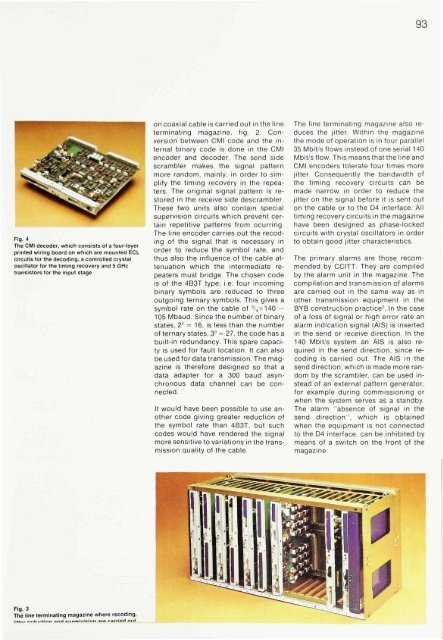diavox courier 700, digital system telephone for md 110 data
diavox courier 700, digital system telephone for md 110 data
diavox courier 700, digital system telephone for md 110 data
Create successful ePaper yourself
Turn your PDF publications into a flip-book with our unique Google optimized e-Paper software.
93<br />
Fig. 4<br />
The CMI decoder, which consists of a four-layer<br />
printed wiring board on which are mounted ECL<br />
circuits <strong>for</strong> the decoding, a controlled crystal<br />
oscillator <strong>for</strong> the timing recovery and 5 GHz<br />
transistors <strong>for</strong> the input stage<br />
on coaxial cable is carried out in the line<br />
terminating magazine, fig. 2. Conversion<br />
between CMI code and the internal<br />
binary code is done in the CMI<br />
encoder and decoder. The send side<br />
scrambler makes the signal pattern<br />
more random, mainly, in order to simplify<br />
the timing recovery in the repeaters.<br />
The original signal pattern is restored<br />
in the receive side descrambler<br />
These two units also contain special<br />
supervision circuits which prevent certain<br />
repetitive patterns from ocurring.<br />
The line encoder carries out the recoding<br />
of the signal that is necessary in<br />
order to reduce the symbol rate, and<br />
thus also the influence of the cable attenuation<br />
which the intermediate repeaters<br />
must bridge. The chosen code<br />
is of the 4B3T type, i.e. four incoming<br />
binary symbols are reduced to three<br />
outgoing ternary symbols This gives a<br />
symbol rate on the cable of 3 / 4 x140 ~<br />
105 Mbaud. Since the number of binary<br />
states, 2 4 = 16, is less than the number<br />
of ternary states, 3 3 = 27, the code has a<br />
built-in redundancy. This spare capacity<br />
is used <strong>for</strong> fault location. It can also<br />
be used <strong>for</strong> <strong>data</strong> transmission. The magazine<br />
is there<strong>for</strong>e designed so that a<br />
<strong>data</strong> adapter <strong>for</strong> a 300 baud asynchronous<br />
<strong>data</strong> channel can be connected.<br />
It would have been possible to use another<br />
code giving greater reduction of<br />
the symbol rate than 4B3T, but such<br />
codes would have rendered the signal<br />
more sensitive to variations in the transmission<br />
quality of the cable.<br />
The line terminating magazine also reduces<br />
the jitter. Within the magazine<br />
the mode of operation is in four parallel<br />
35 Mbit/s flows instead of one serial 140<br />
Mbit/s flow. This means that the line and<br />
CMI encoders tolerate four times more<br />
jitter. Consequently the bandwidth of<br />
the timing recovery circuits can be<br />
made narrow in order to reduce the<br />
jitter on the signal be<strong>for</strong>e it is sent out<br />
on the cable or to the D4 interface. All<br />
timing recovery circuits in the magazine<br />
have been designed as phase-locked<br />
circuits with crystal oscillators in order<br />
to obtain good jitter characteristics.<br />
The primary alarms are those recommended<br />
by CCITT. They are compiled<br />
by the alarm unit in the magazine. The<br />
compilation and transmission of alarms<br />
are carried out in the same way as in<br />
other transmission equipment in the<br />
BYB construction practice 2 . In the case<br />
of a loss of signal or high error rate an<br />
alarm indication signal (AIS) is inserted<br />
in the send or receive direction. In the<br />
140 Mbit/s <strong>system</strong> an AIS is also required<br />
in the send direction, since recoding<br />
is carried out. The AIS in the<br />
send direction, which is made more random<br />
by the scrambler, can be used instead<br />
of an external pattern generator,<br />
<strong>for</strong> example during commissioning or<br />
when the <strong>system</strong> serves as a standby.<br />
The alarm "absence of signal in the<br />
send direction", which is obtained<br />
when the equipment is not connected<br />
to the D4 interface, can be inhibited by<br />
means of a switch on the front of the<br />
magazine.<br />
Fig. 3<br />
The line terminating magazine where recoding,<br />
iiMM- -~^..~*:rt« onH eiinamieinn aro rarripri nut
















